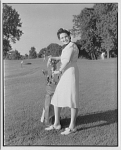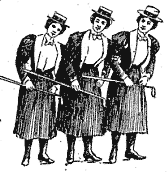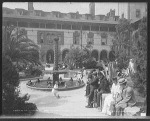Today in History: September 27
Kathy Whitworth, Champion Golfer

Woman With Golf Clubs,
Theodor Horydczak, photographer,
circa 1920-circa 1950.
Washington as It Was, 1923-1959
Professional golf's all-time leading tournament winner Kathy Whitworth was born on September 27, 1939, in Monahans, Texas. Whitworth started playing golf at the age of fifteen. At nineteen she joined the Ladies Professional Golf Association (LPGA) Tour. Over the next fifteen years, she received the LPGA Player of the Year Award seven times.
Whitworth won her first tournament, the Kelly Girl Open, in 1962. Three years later, she was named the Associated Press Athlete of the Year. She received the award again in 1967. For her outstanding performance between 1968 and 1977, Golf Magazine named Whitworth "Golfer of the Decade."
Whitworth was inducted into the LPGA Hall of Fame in 1975, but didn't rest on her laurels. By 1982, she had captured 82 LPGA titles. Whitworth won her 88th in 1985, setting the tournament victory record for a professional golfer, man or woman.
Although she occasionally competes in senior tournaments, Whitworth's focus today is not on winning golf tournaments, but helping other women master the game. She has authored a golf handbook for women and teaches golf clinics nationwide.

Women's Metropolitan Golf Championship,
Nassau Country Club, Long Island, New York, 1913.
Taking the Long View, 1851-1991
Golf first became popular among American women in the mid-1890s when the growing leisure class adopted it as one of its new amusements. Magazines such as Ladies Home Journal urged women to try the sport, a 16th-century favorite of Mary, Queen of Scots.

The Golf Girls,
Excerpt from the vaudeville singing act,
The Clover Trio,
arranged by Samuel H. Speck,
1898.
American Variety Stage, 1870-1920
In golf, many women of privilege found the adventure and challenge missing from their restricted everyday lives. The sport's popularity grew, so that by the 1920s women's amateur golf tournaments were attracting a range of players and large crowds.
In the 1940s and 1950s, golfing greats Babe Didrikson Zaharias, Patty Berg, and others worked to firmly establish the LPGA Tour, the first professional tour for women, and to make their sport more accessible to women of all races and social classes.
In the 60s and 70s, Kathy Whitworth and her peers, including golfing legend Mickey Wright, further developed the LPGA, helping female golfers gain greater acceptance and opportunities for lucrative financial rewards.
- Search across American Memory on golf to see over 200 images of golfers and golf courses.
- For images of other sports, search across the collections on specific sports such as football, basketball, tennis, or crew.
- Baseball fans won't want to miss the collections Jackie Robinson and Other Baseball Highlights, 1860s-1960s, and Baseball Cards, 1887-1914.
- Be sure to see the Today in History features on athletes Jim Thorpe, Satchel Paige, and Althea Gibson, a multi-talented athlete who joined the LPGA Tour after her retirement from professional tennis.
The Quest of Ponce de Leon

Fountain of Youth,
Norton Gallery and School of Art,
West Palm Beach, Florida,
Gottscho-Schleisner, Inc., photographer,
January 17, 1942.
Architecture and Interior Design for 20th Century America, 1935-1955
On September 27, 1514, the Spanish crown granted explorer Juan Ponce de Leon the title Military Governor of Bimini (an island in the Bahamas) and Florida. With this title and the implied permission it contained to colonize those regions, Ponce de Leon sailed for Florida in 1521.
He landed with 200 men and two ships near Charlotte Harbor on Florida's west coast. His arrival did not go unnoticed. Soon the party was attacked by Seminole Indians. During the assault an arrow struck and mortally wounded Ponce de Leon. He returned to Cuba where he died that same year.
This fatal trip was the Spanish explorer's second visit to Florida. In April 1513, Ponce de Leon landed at the site of modern day St. Augustine and named the region Florida because of the lush, florid vegetation which grew there. Thinking he had found the island of Bimini, he searched for the mythical Fountain of Youth which was said to rejuvenate those who drank from it.
Subsequent Spanish incursions in North America led to the founding of a permanent settlement at St. Augustine in 1565. While a fountain of youth was never found, many Americans today enjoy rejuvenating vacations and retirement in Florida.
The Spring of Youth: A Comedy
by Will M. Cressy, 1901.
American Variety Stage, 1870-1920
F:
This is Ponce de Leon's Springs, where you take the baths.
H:
I can't take the baths, I'm too sick.
F:
Good gracious, you don't feel as bad as you look?
H:
Worse.

Court of the Ponce de Leon Hotel,
St. Augustine, Florida,
1905.
Touring Turn-of-the-Century America, 1880-1920
- Find images and documents related to the "Sunshine State." Search the American Memory collections on Ponce de Leon, St. Augustine, or Florida.
- For maps of Florida, see the geographic location map in the collection Panoramic Maps.
- Read La colonización de Puerto Rico, des de el descubrimiento de la isla hasta la reversión á la corona española de los privilegios de Colón, and The History of Puerto Rico, from the Spanish Discovery to the American Occupation to learn more about Ponce de Leon and the early history of Florida, Puerto Rico and the Caribbean. These titles are in the collection Puerto Rico at the Dawn of the Modern Age.
"'On February 10, 1521, he [Ponce de Leon] wrote to the emperor: "I discovered Florida and some other small islands at my own expense, and now I am going to settle them with plenty of men and two ships, and I am going to explore the coast, to see if it compares with the lands (Cuba) discovered by Velasquez.…But the captain's star of fortune was waning. He had a stormy passage, and when he and his men landed they met with such fierce resistance from the natives that after several encounters and the loss of many men, Ponce himself being seriously wounded, they were forced to reembark. Feeling that his end was approaching, the captain did not return to San Juan, but sought a refuge in Puerto Principe, where he died."Chapter XI: Calamities—Ponce's Second Expedition to Florida and Death 1520--1537, in
The History of Puerto Rico, from the Spanish Discovery to the American Occupation, by R. A. Van Middeldyk, 1903.
Puerto Rico at the Dawn of the Modern Age

Alcazar, Cordova, and Ponce de Leon Hotels,
St. Augustine, Florida, 1910.
Taking the Long View: Panoramic Photographs, 1851-1991